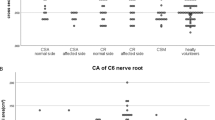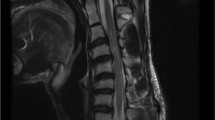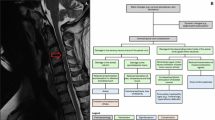Abstract
Study design:
This is a single-center retrospective study.
Objectives:
The objective of this study was to study the clinical symptoms and electrophysiological features of C6–7 myelopathy.
Setting:
This study was conducted at the Department of Orthopedic surgery, Yamaguchi University Graduate school of medicine, Japan.
Methods:
A total of 20 patients with cervical compressive myelopathy were determined by spinal cord-evoked potentials or a single level of obvious magnetic resonance imaging (MRI)-documented cervical spinal cord compression. Neurological examinations included manual muscle testing and investigation of deep tendon reflex, including Hoffmann sign, and of sensory disturbance areas. Motor-evoked potentials (MEPs), compound muscle action potentials (CMAPs) and F-wave were recorded from bilateral abductor digit minim and abductor halluces muscles. Central motor conduction time was calculated as follows: MEPs latency−(CMAPs latency+F latency−1)/2 (ms).
Results:
Eighteen patients (90%) had negative Hoffmann sign. Eight patients (40%) had no sensory disturbance in the upper limbs and 8 patients (40%) had no muscle weakness in the upper limbs. We determined that patients had cervical myelopathy when their central motor conduction time measured in abductor digit minim was longer than 6.76 ms (+2 s.d.). Using this definition, the sensitivity for myelopathy was 42.8%.
Conclusion:
Patients with C6–7 myelopathy may lack clinical symptoms in their hands and central motor conduction time measured in abductor digit minim tended to be less prolonged, and it only showed symptoms in their lower limbs as gait disturbance. Surgeons should bear in mind the possibility of disorders of caudal C6–7 when they encounter patients with no or few symptoms in their hands and with leg weakness or numbness.
Similar content being viewed by others
Log in or create a free account to read this content
Gain free access to this article, as well as selected content from this journal and more on nature.com
or
References
Tani T, Yamamoto H, Kimura J . Cervical spondylotic myelopathy in elderly people: a high incidence of conduction block at C3-4 or C4-5. J Neurol Neurosurg Psychiatry 1999; 66: 456–464.
Imajo Y, Kato Y, Yonemura H, Kanchiku T, Suzuki H, Taguchi T . Relative vulnerability of various spinal tracts in C3-4 cervical spondylotic myelopathy: multi-modal spinal cord evoked potentials. Spinal Cord 2011; 49: 1128–1133.
Kanchiku T, Taguchi T, Kaneko K, Fuchigami Y, Yonemura H, Kawai S . A correlation between magnetic resonance imaging and electrophysiological findings in cervical spondylotic myelopathy. Spine 2001; 26: 269–274.
Brain L, Watson J . Brain's Disease of the Nervous System, 7th edn. Oxford Univesity press: London, UK. 1969, 40–43.
Yoss RE . Significance of symptoms and signs in localization of involved root in cervical disc protrusion. Neurology 1958; 7: 674–685.
Louis R . Surgery of the Spine Surgical Anatomy and Operative Approaches. Spiringer-Verlag: Berlin/Heidelberg/New York. 1983, 86–116.
Seichi A, Takeshita K, Kawaguchi H, Matsudaira K, Higashikawa A, Ogata N et al. Neurologic level diagnosis of cervical stenotic myelopathy. Spine 2006; 31: 1338–1343.
Chiba T, Konoeda F, Higashibara M, Kamiya H, Oishi C, Hatanaka Y et al. C8 and T1 innervation of forearm muscles. Clin Neulophysiol 2015; 4: 837–842.
Rhee JM, Heflin JA, Hamasaki T, Freedman B . Prevalence of physical sign in cervical myelopathy. A prospective, controlled study. Spine 2009; 34: 890–895.
Houten JK, Noce LA . Clinical correlation of cervical myelopathy and the Hoffmann sign. J Neurosurg Spine 2008; 9: 237–242.
Chikuda H, Seichi A, Takeshita K, Shoda N, Ono T, Matsudaira K et al. Correlation between pyramidical signs and the severity of cervical myelopathy. Eur Spine J 2010; 19: 1684–1689.
Nakashima H, Yukawa Y, Suda K, Yamagata M, Ueta T, Kato F . Abnormal findings on magnetic resonance images of the cervical spines in 1211 asymptomatic subjects. Spine 2015; 40: 392–398.
Di Lazzaro V, Restuccia D, Colosimo C, Tonali P . The contribution of magnetic stimulation of the motor cortex to the diagnosis of cervical spondylotic myelopathy. Correlation of central motor conduction to distal and proximal upper limb muscles with clinical and MRI findings. Electrienceph Clin Neurophysiol 1992; 85: 311–320.
Funaba M, Kanchiku T, Imajo Y, Suzuki H, Yoshida Y, Nishida N et al. Transcranial magnetic stimulation in the diagnosis of cervical compressive myelopathy; comparison with spinal cord evoked potentials. Spine 2015; 40: E161–E167.
Nakanishi K, Tanaka N, Sasaki H, Kamei N, Hamasaki T, Yamada K et al. Assessment of central motor conduction time in the diagnosis of compressive thoracic myelopathy. Spine 2010; 35: E1593–E1598.
Ichihara K, Taguchi T, Sakuramoto I, Kawano S, Kawai S . Mechanism of the spinal cord injury and the cervical spondylotic myelopathy: new approach based on the mechanical features of the spinal cord white and gray matter. J Neurosurg 2003; 99: 278–285.
Ono K, Ebara S, Fuji T, Yonenobu K, Fujiwara K, Yamashita K . Myelopathy hand. New clinical sign of cervical cord damage. J Bone Joint Surg Br 1987; 69: 215–219.
Kaneko K, Taguchi T, Morita H, Yonemura H, Fujimoto H, Kawai S . Mechanism of prolonged central motor conduction time in compressive cervical myelopathy. Clin Neurophysiol 2001; 6: 1035–1040.
Nakanishi K, Tanaka N, Fujiwara Y, Kamei N, Ochi M . Corticospinal tract conduction block results in the prolongation of central motor conduction time in compressive cervical myelopathy. Clin Neurophysiol 2006, 623–627.
Matsumoto M, Ishikawa M, Ishii K, Nishizawa T, Maruiwa H, Nakamura M et al. Usefulness of neurological examination for diagnosis of the affected level in patients with cervical compressive myelopathy: prospective comparative study with radiological evaluation. J Neurosurg Spine 2005; 2: 535–539.
Author information
Authors and Affiliations
Corresponding author
Ethics declarations
Competing interests
The authors declare no conflict of interest.
Additional information
Disclaimer
The manuscript submitted does not contain information about medical device(s)/drug(s). No benefits in any form have been received or will be received by a commercial party related directly or indirectly to the subject of this article.
Rights and permissions
About this article
Cite this article
Funaba, M., Kanchiku, T., Imajo, Y. et al. Characteristics of C6–7 myelopathy: assessment of clinical symptoms and electrophysiological findings. Spinal Cord 54, 798–803 (2016). https://doi.org/10.1038/sc.2015.203
Received:
Revised:
Accepted:
Published:
Issue date:
DOI: https://doi.org/10.1038/sc.2015.203
This article is cited by
-
Funicular pain: a case report of intermittent claudication induced by cervical cord compression
BMC Musculoskeletal Disorders (2020)
-
Grip force control during object manipulation in cervical myelopathy
Spinal Cord (2020)
-
The contribution of neurophysiology in the diagnosis and management of cervical spondylotic myelopathy: a review
Spinal Cord (2016)



